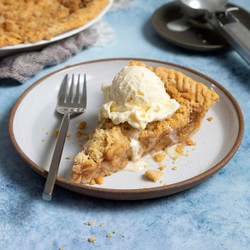In a large bowl, combine the flour and salt. Cut in the shortening using a fork or pastry cutter, and continue doing so until the dough is rough and crumbly. Gradually add cold water a tablespoon or two at a time, tossing with a fork, until the dough is soft enough to come together into a ball. Shape it into a disk, then wrap it tightly in plastic wrap. Refrigerate the dough for at least one hour or up to overnight.
Set your oven to 450°F. Lightly flour a work surface, then roll the dough out to an ⅛-inch-thick circle (about 12 inches round). Carefully transfer the crust to a 9-inch pie plate, making sure not to stretch it. Drape the edges over the pie plate, and trim the crust to ½ inch beyond the rim of the plate. Flute or crimp the crust edges as you like. Editor's Tip: Learn to make the perfect fluted edges, roped edges and other decorative pie crusts.
Take your thinly sliced apples, and lay them in the pie crust. Now, whisk together the sugar, flour and cinnamon in a bowl, and sprinkle this mixture evenly over the apples. Editor's Tip: You don't have to be too careful with arranging your apples perfectly inside the crust, but the more deliberate you are, the tighter the apples will be in the pie, which is ideal. For a simple arrangement, you can lay the apples flat in concentric circles, overlapping from the edge to the center, in layers, until you run out.
In a separate bowl, whisk together the flour, white sugar and brown sugar. Cut in the cold butter until the mixture is crumbly. Sprinkle the mixture evenly over the apple filling.
Bake the pie for 10 minutes. Reduce the oven setting to 350°, and continue baking until the topping is golden brown and the filling is bubbly, 50 to 60 minutes. Let the pie cool on a wire rack, and serve.
